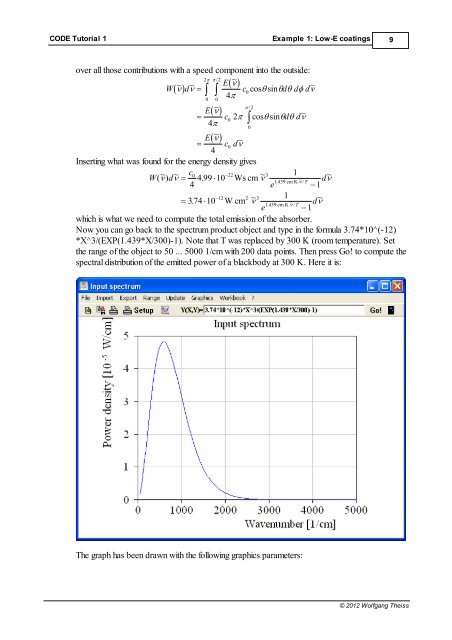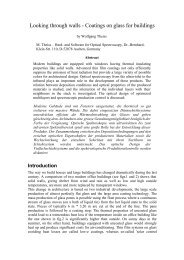CODE Tutorial 1 - W. Theiss Hard- and Software
CODE Tutorial 1 - W. Theiss Hard- and Software
CODE Tutorial 1 - W. Theiss Hard- and Software
Create successful ePaper yourself
Turn your PDF publications into a flip-book with our unique Google optimized e-Paper software.
<strong>CODE</strong> <strong>Tutorial</strong> 1 Example 1: Low-E coatings<br />
over all those contributions with a speed component into the outside:<br />
2 / 2<br />
E<br />
~<br />
W<br />
~<br />
d<br />
~<br />
c cos sin d d d<br />
~<br />
0<br />
4 0 0<br />
E<br />
~<br />
/ 2<br />
c 2 cos sin d d<br />
~<br />
0<br />
4<br />
0<br />
E<br />
~<br />
c d<br />
~<br />
0<br />
4<br />
Inserting what was found for the energy density gives<br />
c<br />
W( d<br />
d T<br />
e<br />
d T<br />
e<br />
~ ) ~ 0 22<br />
.<br />
~ 3 1<br />
4 99 10 Ws cm<br />
~<br />
1. 439 cm K<br />
~<br />
/<br />
4 1<br />
12 2<br />
.<br />
~ 3 1<br />
3 74 10 W cm<br />
~<br />
1. 439 cm K<br />
~<br />
/<br />
1<br />
which is what we need to compute the total emission of the absorber.<br />
Now you can go back to the spectrum product object <strong>and</strong> type in the formula 3.74*10^(-12)<br />
*X^3/(EXP(1.439*X/300)-1). Note that T was replaced by 300 K (room temperature). Set<br />
the range of the object to 50 ... 5000 1/cm with 200 data points. Then press Go! to compute the<br />
spectral distribution of the emitted power of a blackbody at 300 K. Here it is:<br />
The graph has been drawn with the following graphics parameters:<br />
9<br />
© 2012 Wolfgang <strong>Theiss</strong>



